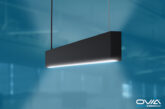
The team at ROBUS share five top tips for reducing energy costs and introducing sustainable lighting concepts on your next project.
As we move towards a more energy conscience world and look for ways to save costs on our energy consumption, we need to find the best products to meet those needs. As the green building market continues to grow, electrical contractors are keen to find ways to introduce energy and sustainability into their plans.
A good energy efficient lighting design can deliver a number of benefits such as:
● Lowering environmental impact,
● Reducing energy costs,
● May have less maintenance due to heat loss,
● Reduces energy losses,
● More optimised lighting.
That’s why we’ve come up with our top five tips for energy saving and sustainable lighting solutions:
1. Take control of your lighting
Lighting controls are automated systems used to control lighting fixtures to deliver the right levels of light at the right time with the aim of optimising energy usage. Lighting controls are paramount in energy saving for this reason as they ensure that the light is not wasted and maximise efficiency. A good lighting design will include a good controls design. These systems include timers, sensors such as Microwave, PIR and Photocell, control switching and dimming of lighting. With uses for both indoors and outdoors, the broad range of applications include benefits such as maximising energy efficiency, complying with green building requirements, and satisfying building codes.
2. Selecting the right Lumen
With lighting, it’s essential to know what light is needed in what room. Sufficient lighting in workspaces or classrooms, for example, can have a direct impact on the user’s mood and productivity. When choosing your lumen value, you should be asking what will the purpose of the light be? For instance, will it be used for reading or relaxing? If the space is under lit it may have adverse effects. Similarly light levels that are too high will result in excess energy consumption so choosing your correct lighting is essential in energy efficiency.
3. Keep your efficacy high
Efficacy is a measurement used to indicate the ability of a light source to emit visible light using a given amount of power – the higher the lumens per watt, the better the result. This means the lamp uses less energy to emit the same or greater amount of light. It also means that for the end user there’s less money spent for the same amount of light. Thus, we recommended that you choose LEDs over traditional incandescent lamps that have typically low efficacy.
4. Work smart, light smart
Smart lighting is a great way to conserve on your energy expenditure. By installing smart elements into homes or businesses, the user can automate the lights to be used only when needed. Smart lighting works similarly to lighting controls in that they contain sensors which can detect various elements like motion, temperature, and the ambient level. Photocell sensors provide daylight harvesting functionality to control lighting levels. They detect the amount of sunlight present and adjust the light levels to allow optimised energy usage. The flexibility of the smart system, with the addition of timed schedules, provides almost limitless options for the application and configuration of sensors. Data on area traffic or occupancy from advanced sensors can also be fed into the system for a virtuous circle to customise the lighting control, leading to typical energy savings of between 40 & 75%.
5. Choose your temperature wisely
Different spaces have different needs, therefore when creating an electrical design, it should reflect the individual requirements of the space. For instance, rooms without access to natural light may place more emphasis on the need for LEDs with colour temperatures that mimic natural daylight. This design can reap a number of benefits to the end user such as improved mood and health, and increased productivity. Placing a focus on designs like these where colour temperatures are the focus point creates an environment that is more user-friendly and flexible, resulting in a longer lasting and sustainable lighting plan.
To browse the latest ROBUS lighting catalogue click here










